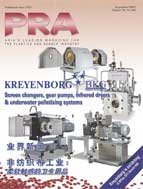 |
 |
In this Edition September 2011 |
LEAD FEATURE |
COMPANY NEWS |
MATERIALS NEWS |
MACHINERY NEWS |
ENVIRONMENT NEWS |
INJECTION MOULDING ASIA |
RUBBER JOURNAL ASIA |
PRA September 2011 Electronic Issue Now Available |
Environment News
Bottle solution for arsenic-contaminated water
W
ith almost 100 million people in developing countries exposed to dangerously high levels of arsenic in their drinking water, and unable to afford complex purification technology, scientists are offering an inexpensive method for removing arsenic based on chopped up pieces of PET bottles coated with a nutrient found in many foods and dietary supplements. And what's more the technology uses discarded PET bottles.The report was part of the 242nd National Meeting & Exposition of the American Chemical Society (ACS), held recently.
"Dealing with arsenic contamination of drinking water in the developing world requires simple technology based on locally available materials," said study leader Tsanangurayi Tongesayi, Ph.D., professor of analytical and environmental chemistry at Monmouth University.
"Our process uses pieces of plastic water, soda pop and other beverage bottles. Coat the pieces with cysteine - that's an amino acid found in dietary supplements and foods - and stir the plastic in arsenic-contaminated water. This works like a magnet. The cysteine binds up the arsenic. Remove the plastic and you have drinkable water."
Tongesayi described laboratory tests of the plastic bottle arsenic removal method on water containing 20 parts per billion (ppb) of arsenic, which is two times the safe standard set by the US Environmental Protection Agency for drinking water. It produced drinkable water with 0.2 ppb of arsenic that more than meets the federal standard.
The technology is so straight-forward that people without technical skills can use it, Tongesayi said, citing that as one of its advantages over some of the existing arsenic-removal technologies.
It can use discarded plastic bottles available locally, and the application of cysteine does not require complicated technology. Tongesayi is seeking funding or a commercial partner, which he said is the key to moving the arsenic-removing process into use in a relatively short time. The technology also has the potential for removing other potentially toxic heavy metals from drinking water.


